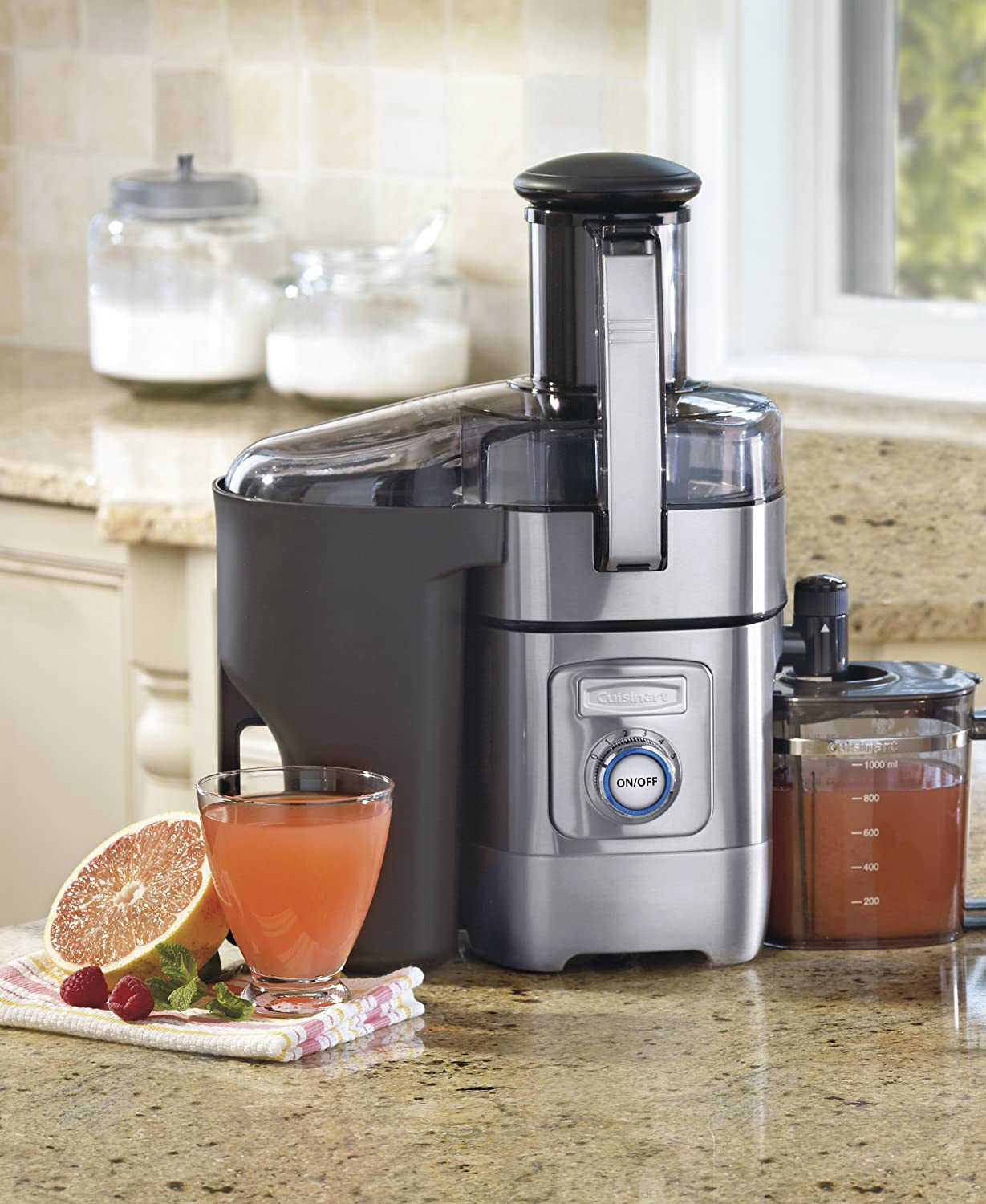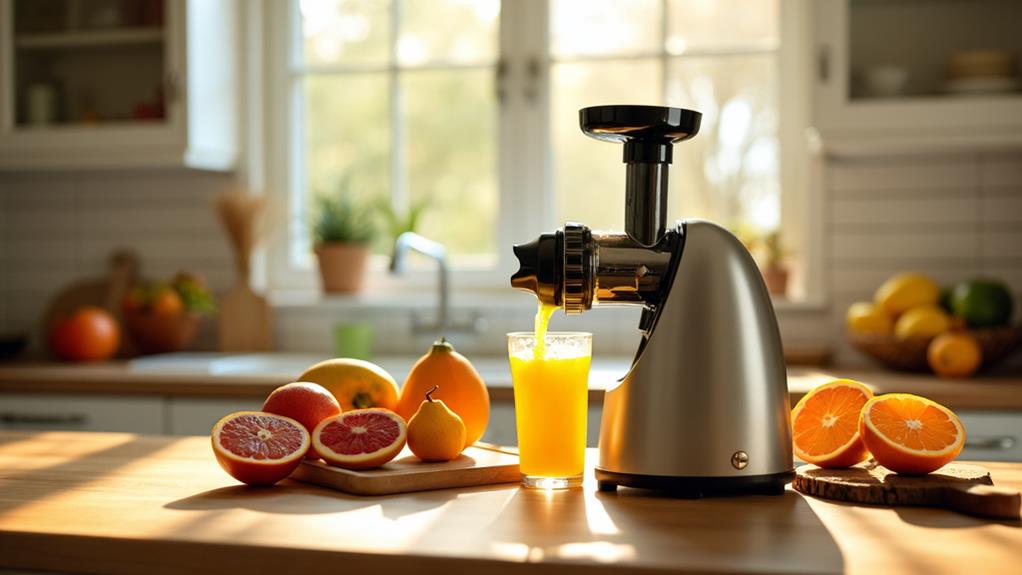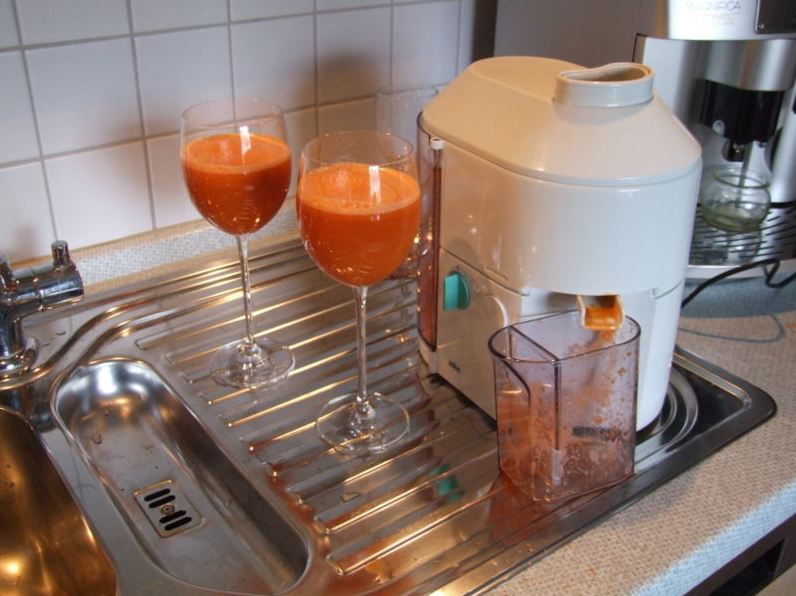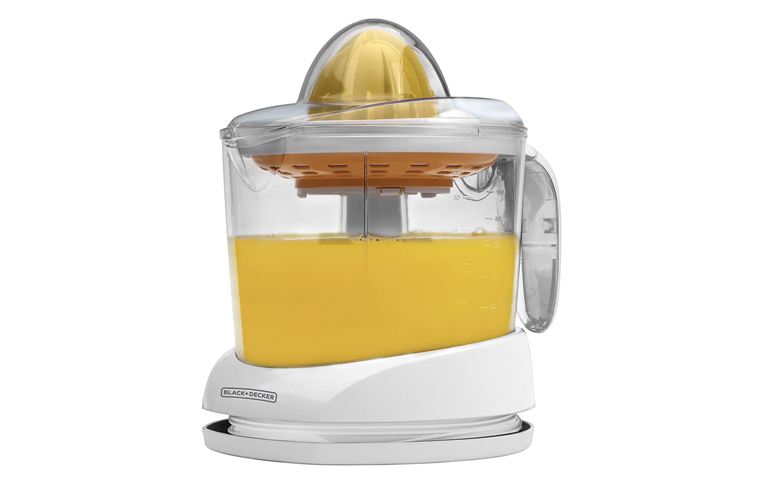Are Expensive Juicers Worth the Investment?
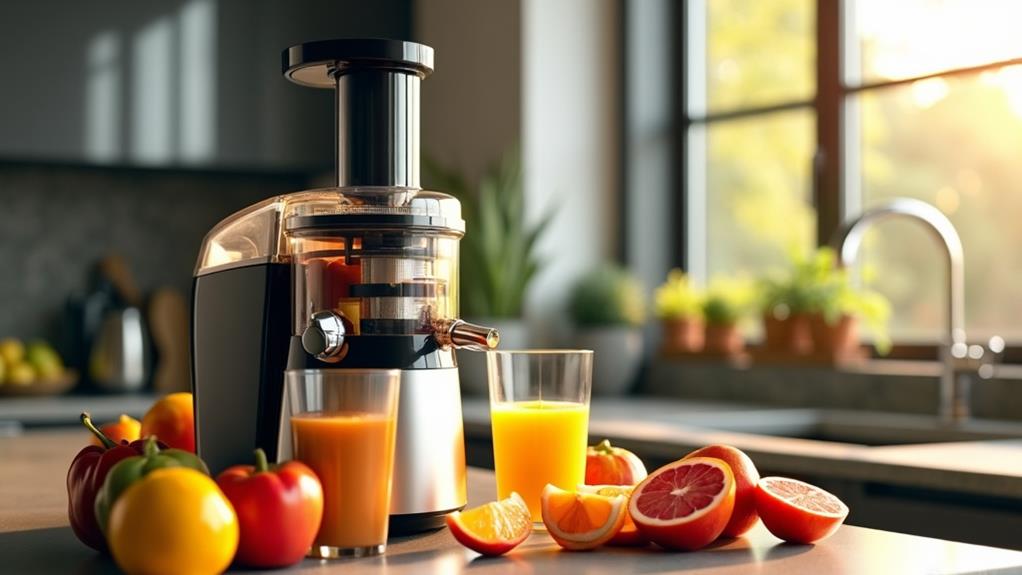
Investing in an expensive juicer can be worth it if you're a frequent juice lover. These high-end juicers often offer greater efficiency, extracting up to 30% more juice and preserving more nutrients than cheaper models. They are easier to clean and built to last, saving you replacement costs and reducing plastic waste. Plus, the cost of homemade juice is substantially less than store-bought options, adding to long-term savings. However, if you juice infrequently, a less expensive model might suffice. Curious about maximizing your juicing habits and environmental impact? There's plenty to investigate on how these juicers fit into your lifestyle.
Types of Juicers
In the domain of juicing, understanding the different types of juicers can help you make the best choice for your needs. Centrifugal juicers are the most affordable option, with a price point between $30 and $100. They're perfect for quickly processing soft fruits and vegetables, thanks to their fast operation and larger feed chutes that let you juice whole produce with ease. If you're looking for something that preserves nutrients better, masticating juicers might be worth the cost. They range from $100 to $300 and use a slower extraction method, resulting in more juice and reduced oxidation for a longer shelf life.
For those considering commercial use or high juice yield, a cold-press juicer, often priced above $300, could be the ideal choice. These are less common in home kitchens but offer exceptional performance. Twin-gear juicers, known for their efficiency in extracting juice from leafy greens, also tend to be on the higher end of the price spectrum due to their intricate design. Finally, citrus juicers are specialized for juicing oranges and lemons. They're generally easy to use and affordable, usually priced under $100, offering great value for citrus lovers.
Price Range Overview
Moving from the types of juicers to their price range, understanding how much you're willing to invest is key to finding the perfect juicer for your lifestyle. If you're on a tight budget, you might contemplate cheap juicers, which typically cost between $30 and $100. However, these often sacrifice quality and ease of cleaning for affordability. Mid-range juicers, priced from $100 to $300, provide a better build quality and performance, striking a balance between cost and functionality.
Expensive juicers, on the other hand, exceed the $300 mark. They boast premium materials, longer durability, and superior juice yield and nutrient retention. If you maintain a regular juice habit, investing in a juicer from this price range might lead to long-term savings. Homemade juice costs considerably less than store-bought options, making expensive juicers a worthwhile investment for frequent juice drinkers.
However, if you drink less than three juices weekly, the initial cost of an expensive juicer might not be justified. In such cases, you may want to contemplate options within the lower or mid-range price brackets to guarantee you get the best value for your money without overspending.
Performance Differences
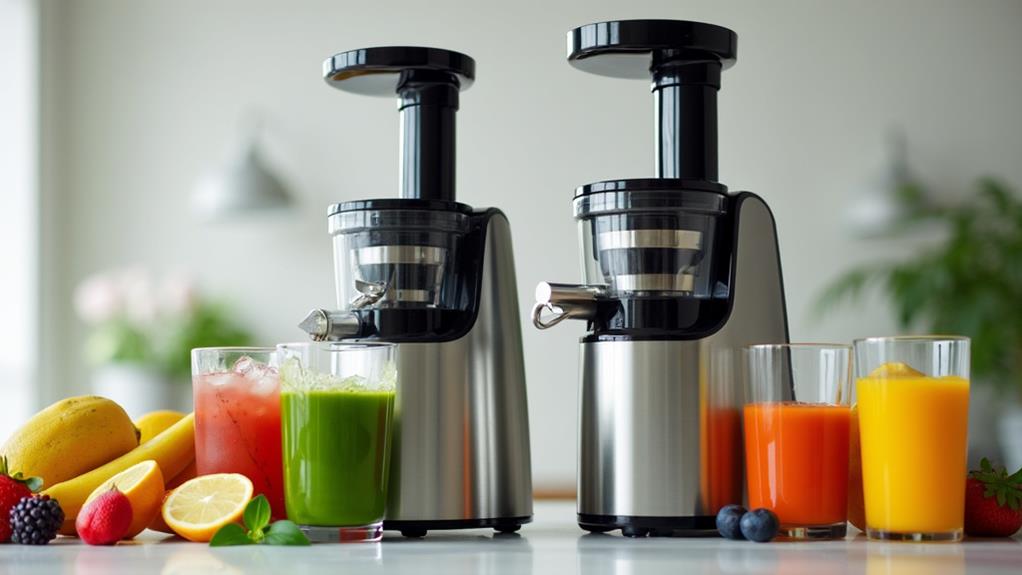
Highlighting the performance differences between expensive and cheaper juicers can guide you in making an informed decision. Expensive juicers, including masticating and twin-gear models, stand out due to their ability to yield more juice and retain more nutrients compared to budget-friendly centrifugal juicers. Masticating juicers, operating at slower speeds (around 60-80 RPM), minimize oxidation, preserving your juice's nutrients and extending its shelf life. You'll notice that juice from masticating models appears clearer and maintains a higher vitamin content than juice from centrifugal juicers, which is often cloudier and oxidizes more quickly.
When it comes to regular juicing, expensive juicers can extract up to 30% more juice from the same produce amount. This efficiency means you get more out of your fruits and vegetables, reducing waste and maximizing your investment. Users often report that the juice tastes better and has a higher quality, which reflects these performance differences. Furthermore, the durability and robust construction of high-end juicers contribute to longer lifespans and less frequent maintenance needs. So, while the initial cost is higher, the improved performance and longevity of expensive juicers can provide significant value over time.
Maintenance and Cleaning
With fewer parts and dishwasher-safe components, expensive juicers simplify the cleaning process considerably. You'll find that these premium models are much easier to maintain compared to cheaper alternatives, which often have complex designs that can be a headache to disassemble and clean. By reducing the number of parts, expensive juicers make it straightforward to clean every nook and cranny, ensuring that you avoid any buildup that can affect the taste and quality of your juice.
Durable materials used in expensive juicers mean less frequent maintenance. These robust components not only extend the lifespan of the juicer but also reduce the time you spend on upkeep. This durability contributes to peak performance, ensuring that your juicer operates smoothly every time you use it. Regular cleaning remains important, but with these user-friendly features, it's less of a chore and more of a quick routine.
User satisfaction is often higher with expensive juicers because cleaning efficiency greatly improves the complete juicing experience. When cleaning is easy, you're more likely to juice regularly, reaping the benefits without the hassle. Say goodbye to the deterrent of complex designs and hello to a more enjoyable juicing adventure.
Cost and Savings
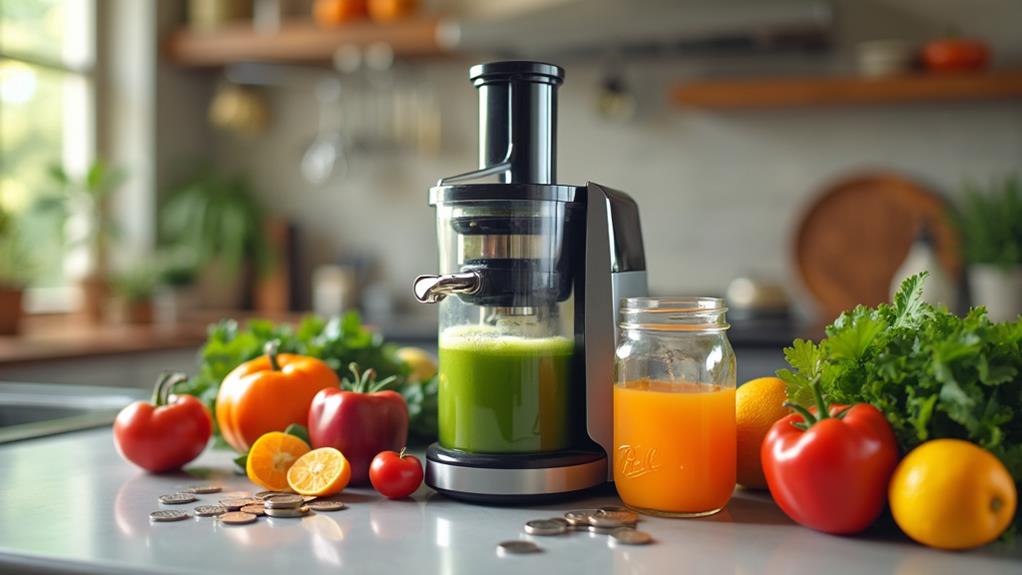
Purchasing a top-tier juicer might seem costly initially, but it can lead to considerable savings over time. Consider this: investing in a quality juicer like the Kuvings Whole Slow Juicer EVO820, priced at $599, can greatly cut your long-term expenses on juice. While this upfront cost may seem intimidating, the annual cost of homemade juice is about $277.68, compared to a hefty $859.56 for store-bought juice when you consume three 12 oz. servings weekly. This means your initial investment in a deluxe juicer is offset by the considerable savings on ingredients over time.
Environmental Impact
Every juice purchase contributes to a mountain of plastic waste, with each consumer adding roughly 156 plastic cups a year if they buy three juices weekly. This significant environmental impact could be reduced by opting for home juicing. By making your own juice, you eliminate the need for single-use packaging and can responsibly dispose of pulp through composting, cutting down on total waste.
Investing in a high-end juicer might seem pricey upfront, but these durable models are built to last anywhere from 5 to 7 years. This longevity means fewer replacements, which in turn lessens your landfill impact. While considering the environmental footprint of juicers, keep in mind that more durable models typically require less frequent manufacturing, thereby reducing their long-term environmental impact.
If you're eco-conscious, you might also look into juice bars practicing sustainable sourcing and using biodegradable packaging, which are more environmentally friendly options compared to those relying on single-use containers. However, home juicing remains a strong contender for reducing plastic waste. By choosing the right juicer and managing waste responsibly, you can enjoy fresh juice while minimizing your environmental footprint.
Convenience and Lifestyle
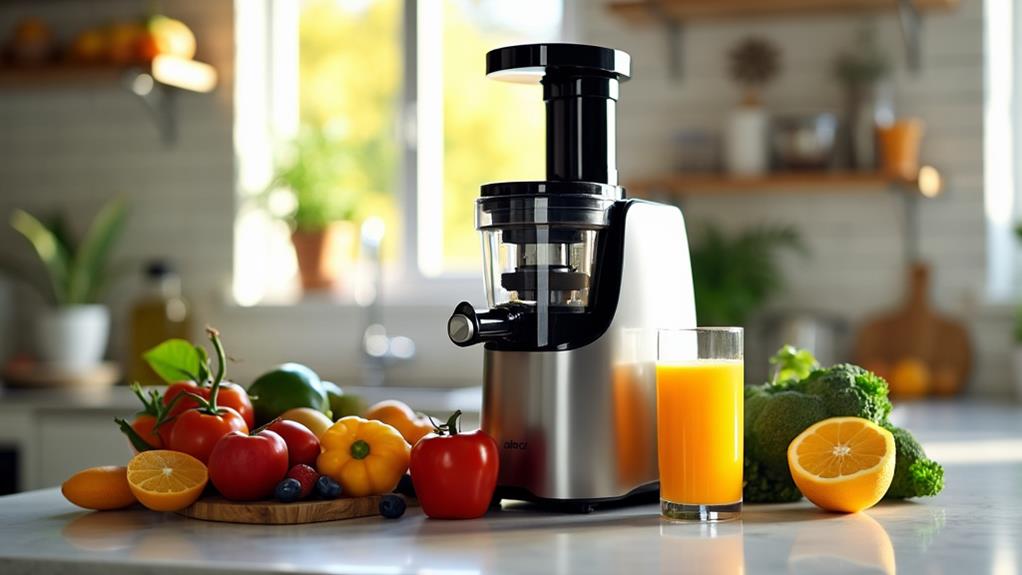
When deciding between home juicing and store-bought options, convenience often plays a significant role. If you're juggling a busy lifestyle, you might find the time and effort required for home juicing a bit intimidating. Preparation and cleaning can quickly add up, making a quick stop at your local cafe for fresh juice more appealing. However, don't forget the taste and nutritional benefits that freshly made juice provides, which can be a worthwhile investment in your health if you drink it daily.
Home juicing also offers the perk of customization. You can tailor flavors and ingredients to your liking, something pre-packaged juices can't always match. Yet, if you drink juice less than three times a week, the convenience of buying might outweigh the cost and effort of investing in a high-quality juicer.
Consider kitchen space as well. Storing a juicer on your benchtop keeps it accessible, encouraging more frequent use. But if space is tight, this might be impractical for your home setup. Ultimately, the decision of home juicing fitting into your lifestyle will depend on balancing convenience, the desire for fresh juice, and your available kitchen space.
User Feedback and Recommendations
Investing in a high-end juicer can transform your juicing experience, as user feedback often highlights. High-end juicers are generally praised for delivering notably higher juice yield and better nutrient retention compared to their budget counterparts. Users of models like the Omega Compact Nutrition System and Kuvings Whole Slow Juicer Elite find that the initial cost is justified, especially if you're a frequent juicer. These machines not only optimize the amount of juice extracted but also guarantee you get the most nutrients from your produce.
Customer feedback underscores the superior juice quality offered by high-end juicers. Reviews point out that these models produce clearer, less foamy juice, which improves your comprehensive drinking experience. Unlike budget options that may leave you with cloudy juice and excessive foam, high-end juicers deliver a smoother, more flavorful result.
The ease of cleaning is another notable advantage. Many premium juicers feature dishwasher-safe components, which simplifies the cleaning process and reduces the hassle associated with regular juicing. Furthermore, the extensive warranties, like the 15-year coverage from Omega, provide long-term value and peace of mind, making these high-end options a worthwhile investment.

